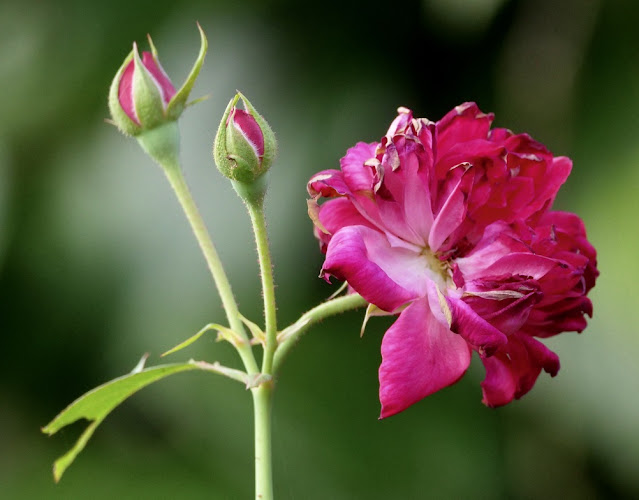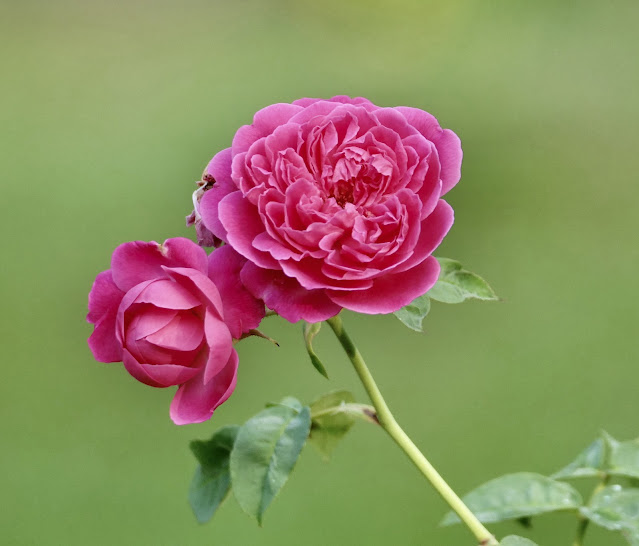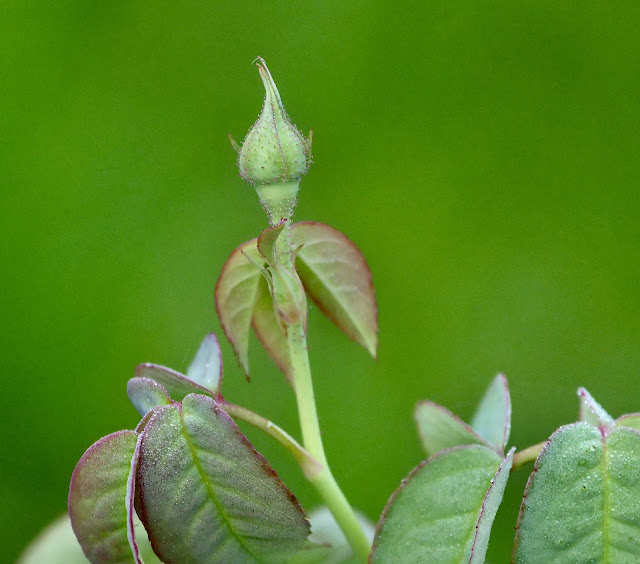I took time to visit the photos of rose flowers of January and early February 2025.
The last six weeks engaged our attention to seal every gap in our cottage, and farm houses from the invasion of Indian Civet an animal who normally lives in forests and under the cover thick vegetations. They are nocturnal animals looking similar to a cat and come at night searching for food. For a month we had an invasion of this animal to our cottage and farm houses causing some damage. Our domestic helper was enthusiastic and active to cover the gaps in the roof to prevent the animal from access inside our cottage and farm houses. This distracted us from paying attention to the rose bushes, when the summer heat along with some pests damaged the bush and flowers.
I found four categories of rose flowers, while going through the photos of the last six weeks.
1. The normal withering of the rose flower
The following four photographs show how a flower would fade away after five to six days. The healthy looking petals fall of and remain in the soil.


2.The damaged flowers.
The six photos below are of damaged flowers due to insects who make the flowers vulnerable with its slimy body and excreta. Some spiders and caterpillars eat the petals. Wit the summer heat reaching about 36 degree celsius, the rose bushes who are exposed to the sunlight all through the day are more vulnerable as the slimy substance left by the insects cause the petals to shrivel and dry up in the heat of the day, although they are watered every day.
These flowers do not last for two or three days. They have a miserable look, unlike the fresh, fragrant and flowery look.




3. The Resilient Flowers.
The six photos of the flowers below show indications of being affected by the insects. Each flower or bud carries a mark of the damage caused by the invading insects.
The flowers are resilient enough to withstand a hostile situation and stay on for its normal span of five to six days. The insects which attack the leaves or buds do greater harm as they thrive on the juice from the leaves and buds. They are likely to invade the tender leaves and the buds.

4. The Thriving flowers
I noticed that some flowers overcame the pests and the summer heat. The ten photos below tell that story of how some rose bushes are inherently endowed to withstand hostile conditions.
One reason why rose bushes ought to be in non shady places is the advantage it offers them to receive dew of the night during the winter months. Often the rose flowers look brighter, larger and healthier during the winter months due to the variation in the day and night temperature.

We missed spraying the nutrients and the pesticides during the one month, when we were fighting the Indian Civet from making a permanent residence in our garden. Our flowering plants suffered by this distraction.
Some friends, tell me that I use every observation to connect with child development. Pardon me, I have to do that again.
The damaged flowers and the resilient flowers tell me something about child development.
Children need protection of attention and insulation for them to be resilient as they grow and develop. It is not the Television or phones which provide that.
It is the presence of parents, trusted care givers and companions who contribute to the formation of their conduct, character, relationships, selfhood, values, orientation to life and social behaviour.
A seven year old boy told me, that he was unhappy that his parents did not buy a gun for his birthday. The boy wanted a gun because he watched soldiers carrying gun in the Gaza region. For him, it became a symbol of gallantry. I am not surprised by this as he is entering the 'cow boy' season of his life where chivalry for a boy is a value. But what is disturbing is that the gun became a symbol of his aspiration.
For Francis of Assisi, the symbol at this age in his life, was a longing to 'flee' from the glamour of his riches to embrace the needs of the poor in his neighbourhood. That too is chivalry, but of a different nature, where upbuilding others is the motivation and not destroying others as it occurs in a war.
I feel good that I was guided to revisit the photos of the rose flowers of the last six weeks in our garden- I realise that the rose flowers do not have a voice to call my attention. They have their colourful and fragrant presence in the garden swaying in the gentle breeze inviting the insects and bees to come to feed on the nectar. It has a giving language. But I did not carry a receiving language within amidst the pre-occupations.
This exercise helped me to prepare more space to receive the giving flowers! It is when I receive them, I become aware of the vulnerable situations they are in!
Is it not true about child development! Receiving children would mean staying aware of them, being present to them and feeling with them as they face the ordeals of their formative process.
That is how parenting becomes a delightful experience and central to the temper and routine of a home !
M.C.Mathew(text and photo)


























No comments:
Post a Comment